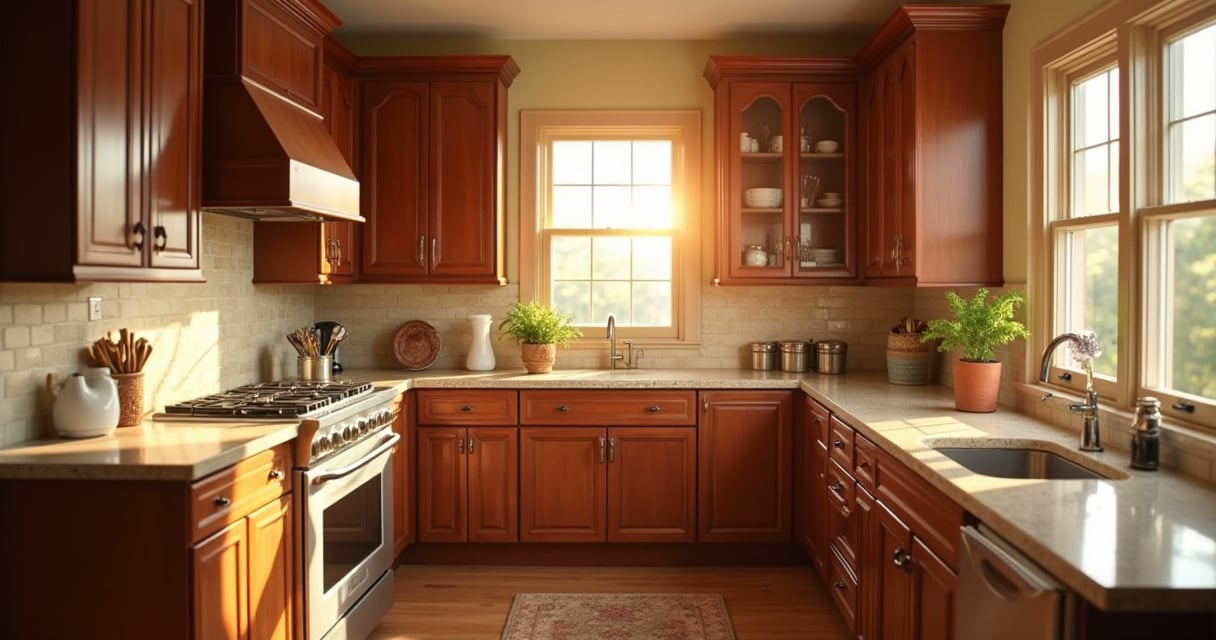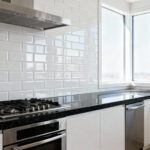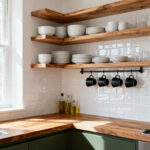When you walk into a kitchen that truly feels like home, chances are brown tones are working their quiet magic. This foundational color, often overlooked in favor of trending whites and grays, possesses an unmatched ability to create spaces that feel both sophisticated and deeply welcoming. From the rich grain of walnut cabinetry to the warm glow of honey-colored hardwood floors, brown brings an organic authenticity that transforms kitchens from mere cooking spaces into the genuine heart of the home.
The environmental story behind choosing brown for your kitchen runs deeper than aesthetics. Natural wood tones connect us to the outdoors, supporting our innate need for biophilic design elements that reduce stress and enhance well-being. When we select sustainably sourced materials in various brown hues, we’re not just creating beautiful spaces – we’re making choices that honor the forests and craftspeople who bring these materials to life. Each brown kitchen idea in this collection celebrates this connection while proving that eco-conscious design never compromises on style.
These 24 brown kitchen ideas showcase the remarkable versatility of this timeless palette, from dramatic dark espresso statements to light, airy honey oak foundations. Whether you’re drawn to the rustic charm of reclaimed barn wood or the sleek sophistication of contemporary walnut, you’ll discover how brown’s various incarnations can anchor your design while creating the warm, inviting atmosphere that makes every meal feel like a celebration.
1. Choose Rich Walnut Cabinets for Timeless Elegance
Rich walnut cabinets represent the pinnacle of natural beauty in kitchen design, offering deep chocolate tones with distinctive grain patterns that create instant sophistication. The inherent durability of walnut, combined with its naturally occurring oils that resist moisture, makes it an investment piece that actually improves with age. This hardwood’s Janka rating of 1,010 ensures it withstands daily kitchen activities while developing a beautiful patina that tells the story of your family’s daily rituals.
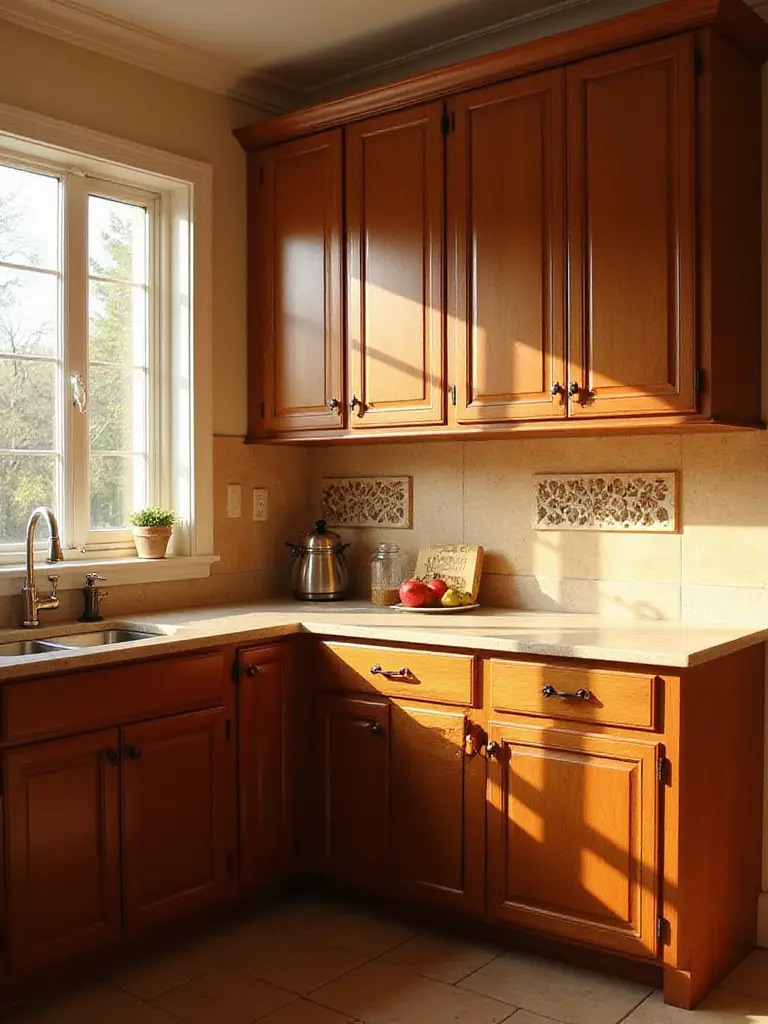
The magic of walnut lies in its ability to shift throughout the day as natural light changes, revealing subtle purple and gray undertones that add depth and complexity to your kitchen palette. Unlike painted surfaces that can chip or show wear, walnut’s natural variations actually help camouflage minor scratches and dings, making it incredibly practical for busy households. Professional furniture makers have prized this species for centuries because its grain structure creates visual movement that prevents large expanses of cabinetry from appearing flat or monotonous.
- Grain Selection: Choose rift-sawn walnut for consistent, straight grain patterns, or book-matched panels for dramatic cathedral patterns
- Finish Options: Consider hand-rubbed oil finishes that enhance the wood’s natural character versus lacquered surfaces for easier maintenance
- Hardware Pairing: Brushed brass or matte black hardware creates stunning contrast against walnut’s rich tones
The craftsmanship in walnut cabinetry tells a story of sustainable forestry practices, as responsible harvesting actually helps maintain healthy forest ecosystems…
2. Install Warm Honey Oak Flooring for Natural Foundation
Honey oak flooring provides the perfect foundation for brown kitchen ideas, offering golden undertones that reflect light beautifully while maintaining the durability needed for high-traffic areas. This sustainable choice, when sourced from responsibly managed forests, supports regenerative forestry practices while bringing warmth that makes bare feet want to linger on its surface. The natural variation in honey oak’s grain patterns creates visual interest that prevents large floor areas from appearing monotonous, while its medium hardness rating provides excellent longevity.
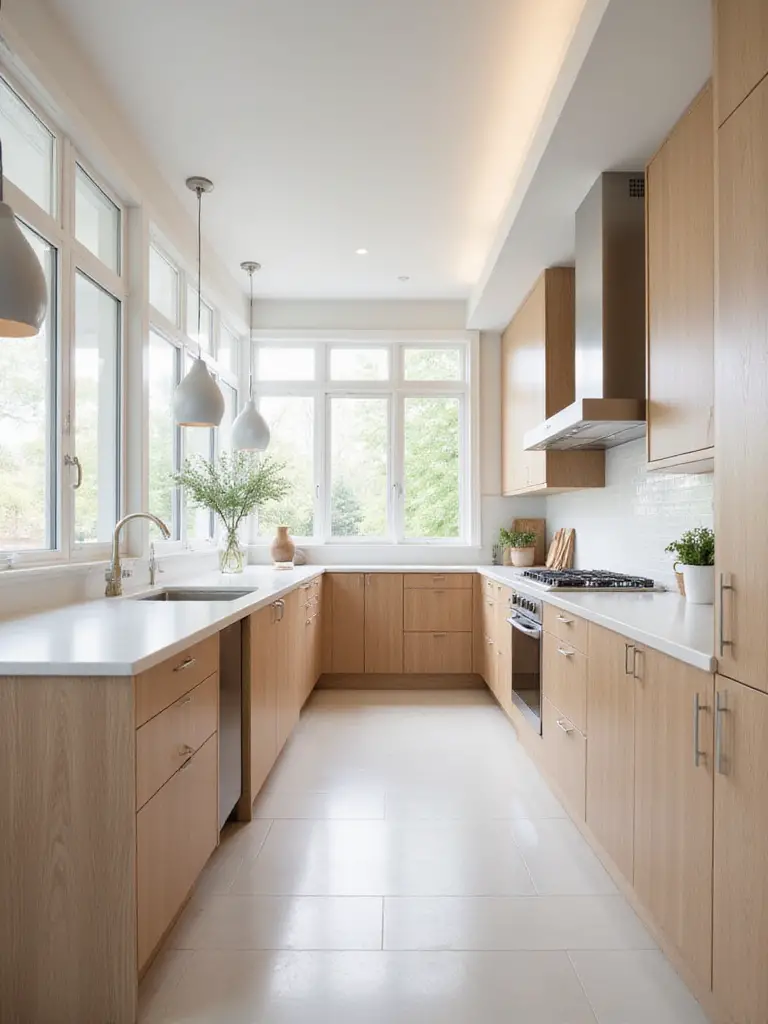
The thermal properties of oak flooring create a more comfortable cooking environment, as wood naturally insulates better than stone or tile, reducing fatigue during long cooking sessions. When properly finished with low-VOC polyurethane or natural oil treatments, honey oak floors contribute to healthier indoor air quality while developing a rich patina over time. The quarter-sawn cutting method reveals the wood’s distinctive ray patterns, creating subtle texture that catches light throughout the day and adds depth to your kitchen’s visual foundation.
- Plank Width: Wider planks (5-7 inches) showcase the wood’s natural grain patterns more dramatically
- Installation Method: Nail-down installation over plywood subfloors provides superior stability and longevity
- Maintenance: Annual deep cleaning with pH-neutral wood cleaners preserves the finish and natural oils
What makes this choice better for our planet is the carbon sequestration that continues even after installation, as the wood maintains its stored carbon for decades…
3. Create Drama with Espresso-Stained Kitchen Islands
An espresso-stained kitchen island commands attention while providing a sophisticated anchor point that grounds the entire space in rich, coffee-inspired tones. This deep brown finish works particularly well on islands because it creates a furniture-like quality that distinguishes the piece from surrounding cabinetry, essentially creating a statement piece that serves multiple functions. The dark stain penetrates deep into the wood grain, creating durability that resists water rings and daily wear while maintaining its lustrous appearance for years.
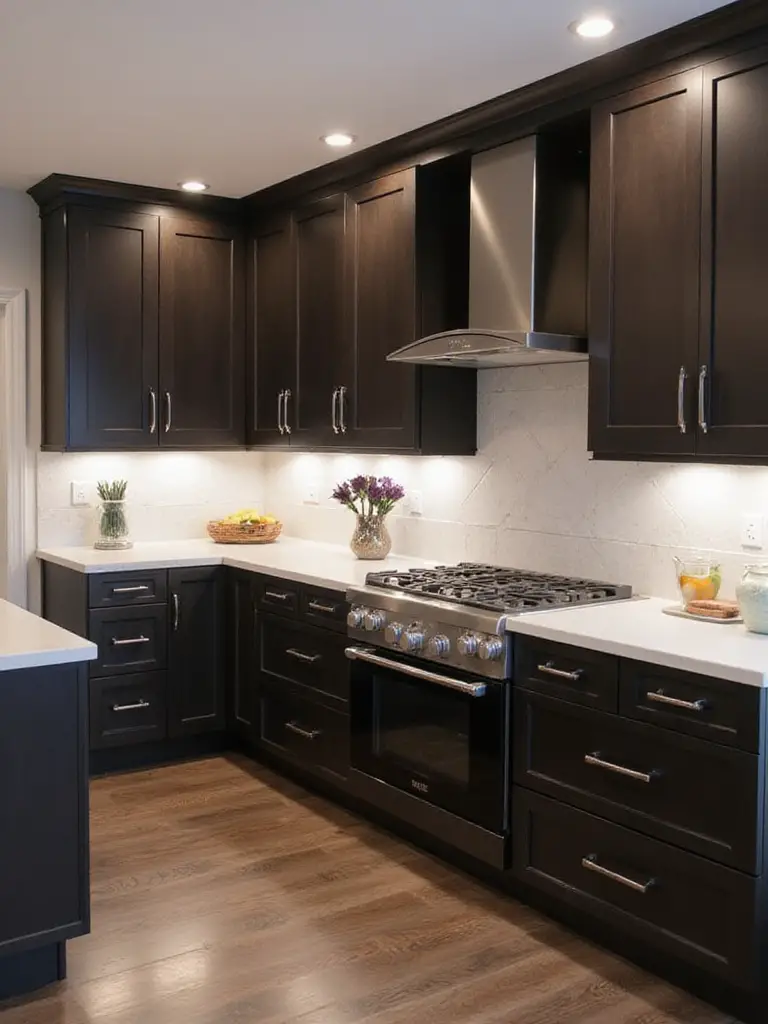
The psychological impact of a dark island center creates a gathering point that naturally draws family and guests, making it the unofficial heart of kitchen activity. Professional kitchen designers often specify espresso stains on islands because the darker color provides visual weight that balances lighter perimeter cabinets, creating sophisticated contrast without overwhelming the space. The richness of espresso staining allows the wood’s natural grain to show through while unifying different wood species under one cohesive tone.
- Wood Species: Maple and cherry take espresso stain most evenly due to their tight grain structure
- Prep Work: Proper sanding and wood conditioning ensure uniform stain penetration
- Protective Finish: Multiple coats of water-based polyurethane provide durability without yellowing
The unexpected environmental benefit comes from choosing locally sourced hardwoods for your island, reducing transportation emissions while supporting regional forestry jobs…
4. Pair Light Brown Cabinets with Marble Countertops
Light brown cabinets paired with marble countertops create a sophisticated balance that feels both timeless and fresh, allowing the natural veining in marble to become artwork against the warm wood backdrop. This combination works particularly well in kitchens with abundant natural light, where the marble’s crystalline structure reflects illumination while the wood absorbs it, creating dynamic interplay throughout the day. The thermal mass of marble provides practical benefits for baking, while the wood’s warmth prevents the space from feeling cold or sterile.
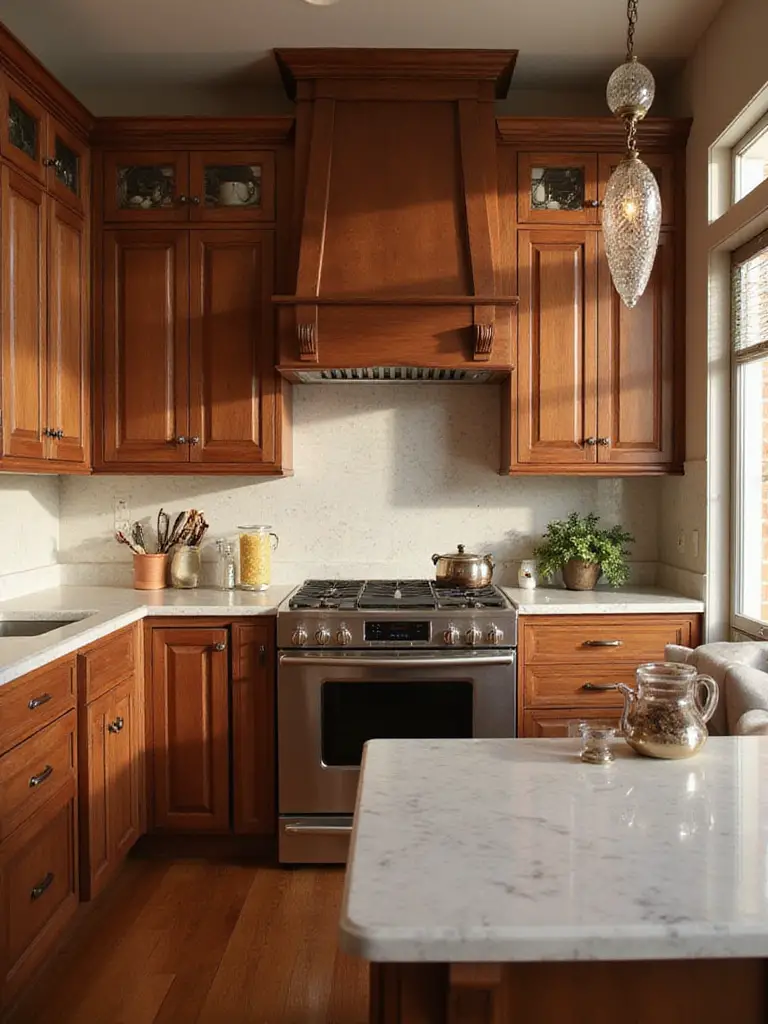
Selecting marble with brown or warm gray veining creates harmony with light brown cabinetry, while the stone’s natural variations ensure no two installations look identical. The environmental consideration here involves choosing marble from quarries that practice responsible extraction and support local communities, as many family-owned quarries have operated sustainably for generations. The longevity of both materials means this combination can serve beautifully for decades with proper care, making it a sustainable choice that transcends trends.
- Marble Selection: Calacatta Gold or Emperador Light offer warm veining that complements brown tones
- Edge Profiles: Subtle beveled or eased edges maintain the natural, understated elegance
- Sealing Schedule: Annual sealing protects marble from stains while preserving its natural beauty
Beyond aesthetics, the ecological impact matters because choosing natural stone over synthetic alternatives supports traditional quarrying communities and reduces industrial manufacturing emissions…
5. Incorporate Reclaimed Wood Beam Accents
Reclaimed wood beams bring authentic character and environmental responsibility to brown kitchen designs, showcasing the beauty of materials that have already lived full lives in barns, factories, or historic buildings. These weathered timbers carry stories in their grain patterns, nail holes, and natural patina that simply cannot be replicated in new lumber. The carbon footprint of reclaimed beams is significantly lower than new timber since no additional trees are harvested, and the embodied energy from original processing is preserved and repurposed.
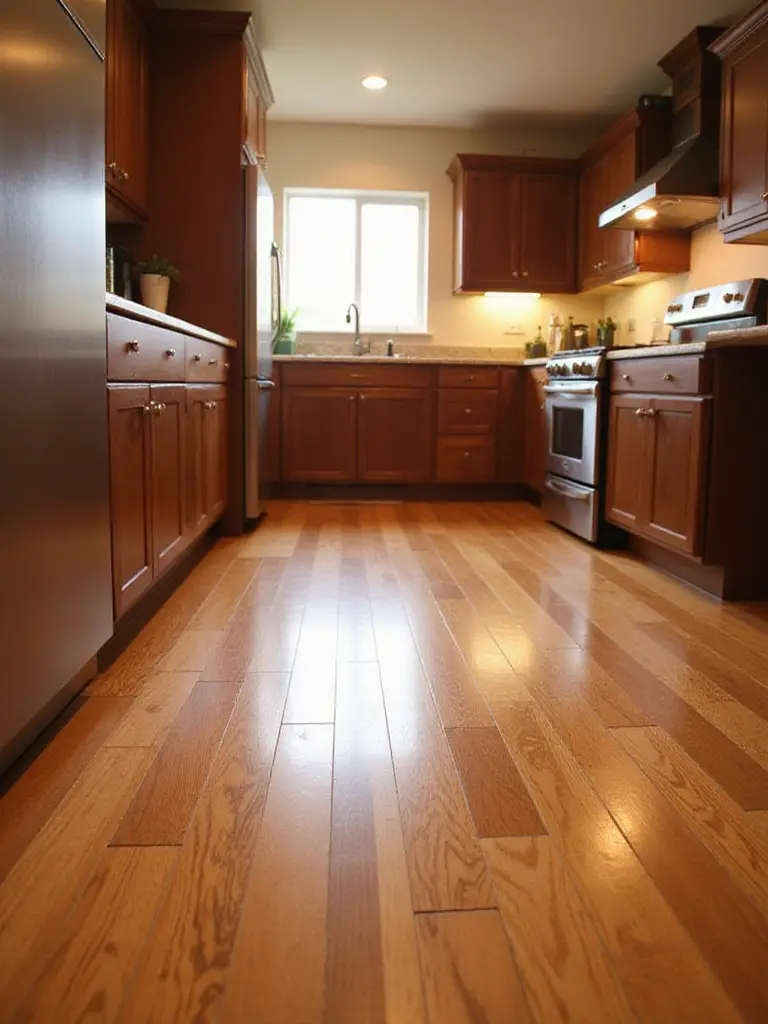
The structural integrity of reclaimed beams often exceeds modern lumber because they come from old-growth forests where trees grew slowly, creating denser, more durable wood. Installing these beams as decorative elements or functional supports adds architectural interest while connecting your kitchen to sustainable building practices. The varied brown tones in reclaimed wood – from silvered gray-brown to rich chocolate – create natural color gradation that adds depth and prevents monotony in brown-themed kitchens.
Professional restoration of reclaimed beams involves careful cleaning, pest treatment, and stabilization while preserving the authentic wear patterns that make each piece unique. The installation process requires structural engineering assessment to ensure proper support, but the resulting visual impact transforms ordinary kitchens into spaces with genuine historical character.
The artisan collective that sources and prepares reclaimed beams often includes craftspeople who specialize in architectural salvage, supporting traditional skills while diverting valuable materials from landfills…
6. Design Custom Brown Tile Backsplashes
Custom brown tile backsplashes offer unlimited creative potential while supporting artisan communities that specialize in handcrafted ceramics and natural stone. The variety available in brown tiles – from chocolate subway tiles to terra cotta mosaics – allows for personalized expression while maintaining the warm, earthy aesthetic that defines brown kitchen ideas. Handmade tiles often feature slight variations in color and texture that create visual interest and prevent the mechanical uniformity of mass-produced alternatives.
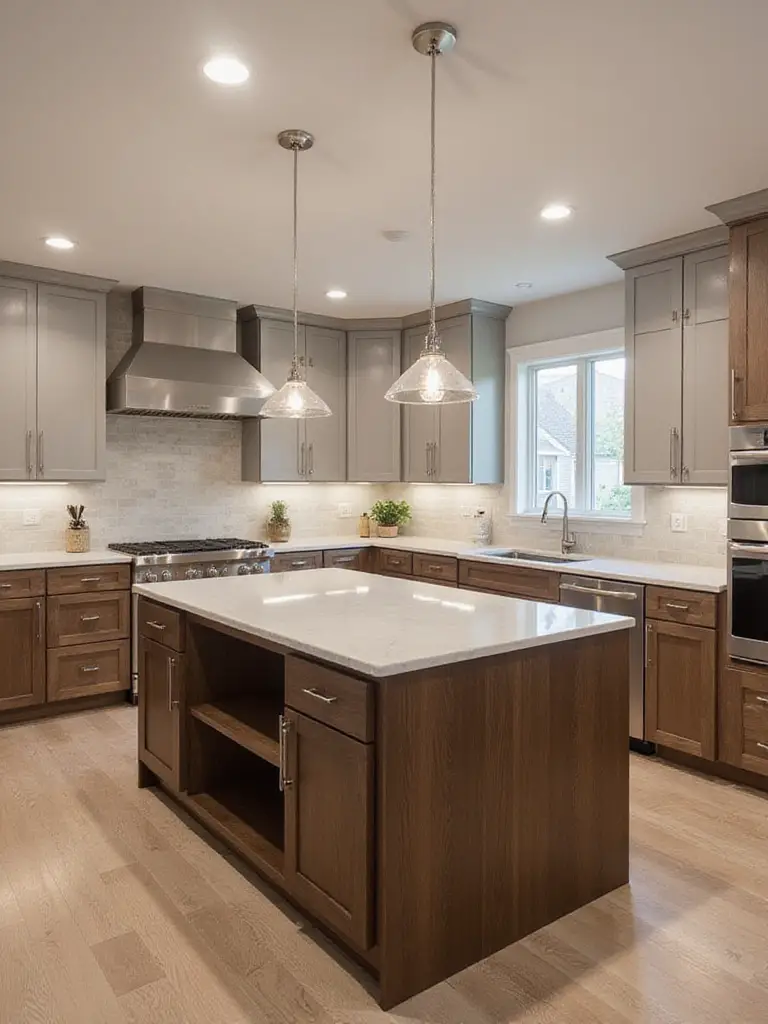
The thermal properties of ceramic and stone tiles provide practical benefits behind cooking areas, as they resist heat and moisture while being easy to clean with environmentally friendly products. Choosing tiles made from locally sourced clay or recycled materials reduces transportation emissions while supporting regional ceramic traditions. The installation process allows for creative patterns – herringbone, basketweave, or running bond – that add architectural interest while showcasing the tiles’ natural beauty.
- Material Options: Terra cotta, chocolate ceramic, or brown natural stone each offer distinct character
- Grout Selection: Matching or contrasting grout colors dramatically affect the final appearance
- Pattern Planning: Mock up different layouts before installation to ensure desired visual impact
The sustainable journey of handmade tiles involves clay sourced from regional deposits, fired in kilns powered by renewable energy, and crafted by artisans who maintain traditional techniques…
7. Select Butcher Block Countertops for Warmth
Butcher block countertops bring living warmth to brown kitchens while providing a renewable surface that can be sanded and refinished multiple times throughout its lifespan. The natural antimicrobial properties of certain hardwoods, particularly maple and cherry, make them practical choices for food preparation while contributing to the overall brown palette. This sustainable option requires significantly less energy to produce than stone or synthetic surfaces, and at the end of its useful life, wood can be composted or repurposed rather than ending up in landfills.
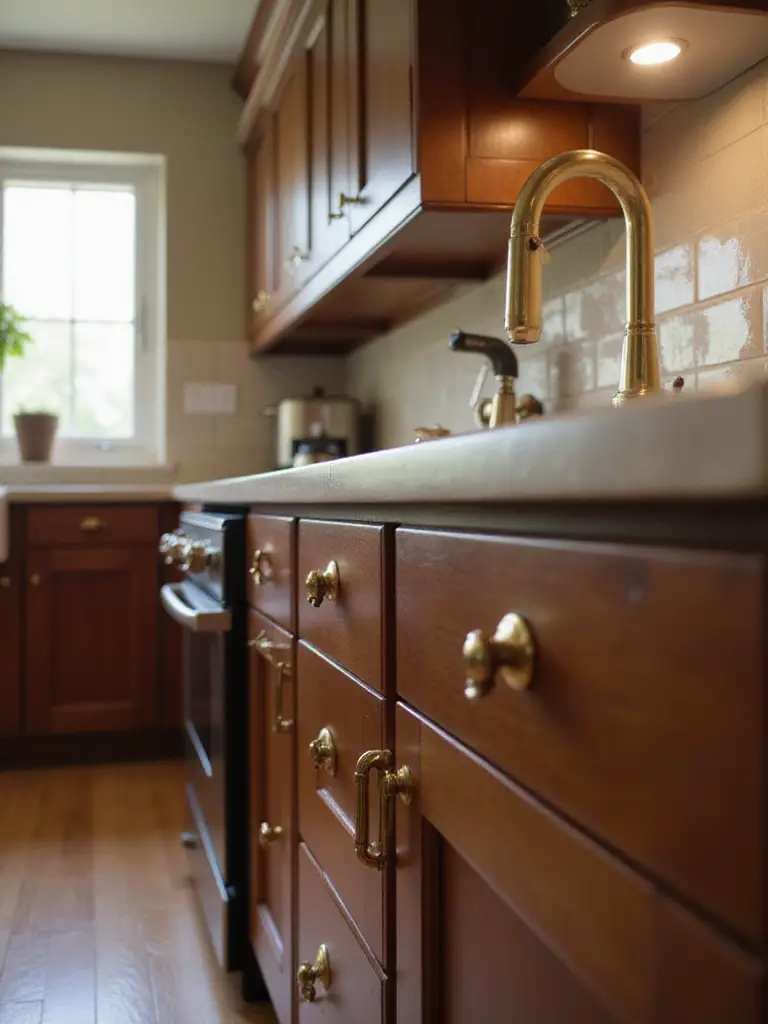
The tactile experience of working on wood changes the entire cooking process, providing a surface that’s gentle on knives while offering natural give that reduces hand and wrist fatigue during extended prep sessions. Different wood species contribute varying brown tones – from the pale honey of maple to the rich chocolate of walnut – allowing customization within the brown palette. Regular maintenance with food-safe mineral oil and beeswax creates a protective barrier while enhancing the wood’s natural grain patterns.
- Wood Species: End-grain maple provides maximum durability for heavy-use areas
- Thickness Options: 1.5-inch thickness offers good stability, while 2.5-inch creates more substantial appearance
- Maintenance Kit: Food-safe mineral oil and fine-grit sandpaper for periodic refinishing
The forest where this wood grew stands within 500 miles of most North American customers, significantly reducing transportation emissions while supporting regional forestry management…
8. Install Warm Brown Subway Tiles
Warm brown subway tiles offer a fresh interpretation of the classic format while maintaining the timeless appeal that has made subway tiles a design staple for over a century. These tiles, whether crafted from natural clay or recycled materials, provide durability and easy maintenance while contributing rich, earthy tones to brown kitchen schemes. The elongated rectangular shape creates visual lines that can make spaces appear larger when installed horizontally or taller when stacked vertically.
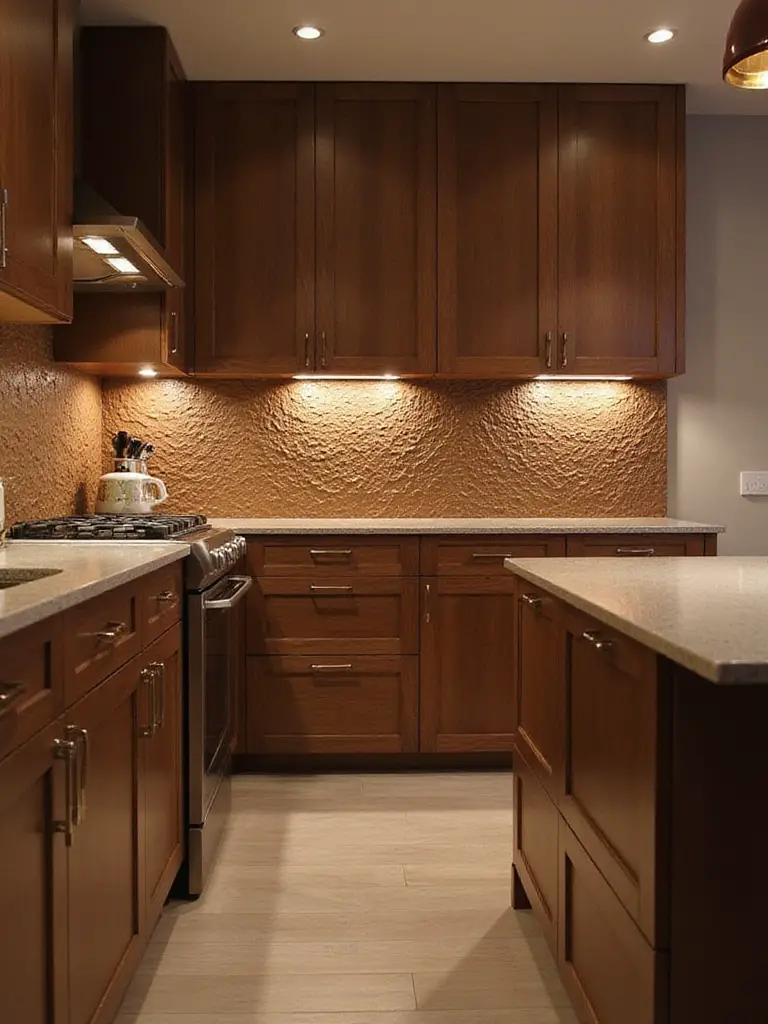
The manufacturing process for quality brown subway tiles often involves traditional kiln-firing techniques that create subtle color variations within each tile, preventing the mechanical uniformity that can make spaces feel sterile. Many artisan tile makers use locally sourced clay and natural iron oxides to achieve authentic brown tones, supporting traditional ceramic arts while reducing the environmental impact of long-distance shipping. The installation flexibility allows for creative patterns beyond traditional running bond – herringbone, vertical stack, or diagonal layouts add personality while maintaining the tiles’ classic appeal.
- Size Variations: 3×6 inches is traditional, but 2×8 or 4×12 inches offer contemporary proportions
- Finish Options: Glossy finishes reflect light, while matte surfaces provide subtle texture
- Installation Patterns: Herringbone pattern adds visual interest while maintaining subway tile character
The third-generation workshop where these tiles come to life maintains traditional firing methods that use 30% less energy than industrial production while creating superior durability…
9. Choose Chocolate Brown Kitchen Cabinets
Chocolate brown kitchen cabinets create an enveloping sense of luxury and sophistication while providing a rich backdrop that makes other elements in the kitchen truly shine. This deep, warm tone works particularly well in larger kitchens where the richness won’t overwhelm the space, instead creating a cozy, intimate atmosphere that encourages gathering and conversation. The psychological impact of chocolate brown promotes feelings of stability and comfort, making the kitchen feel like a true sanctuary within the home.
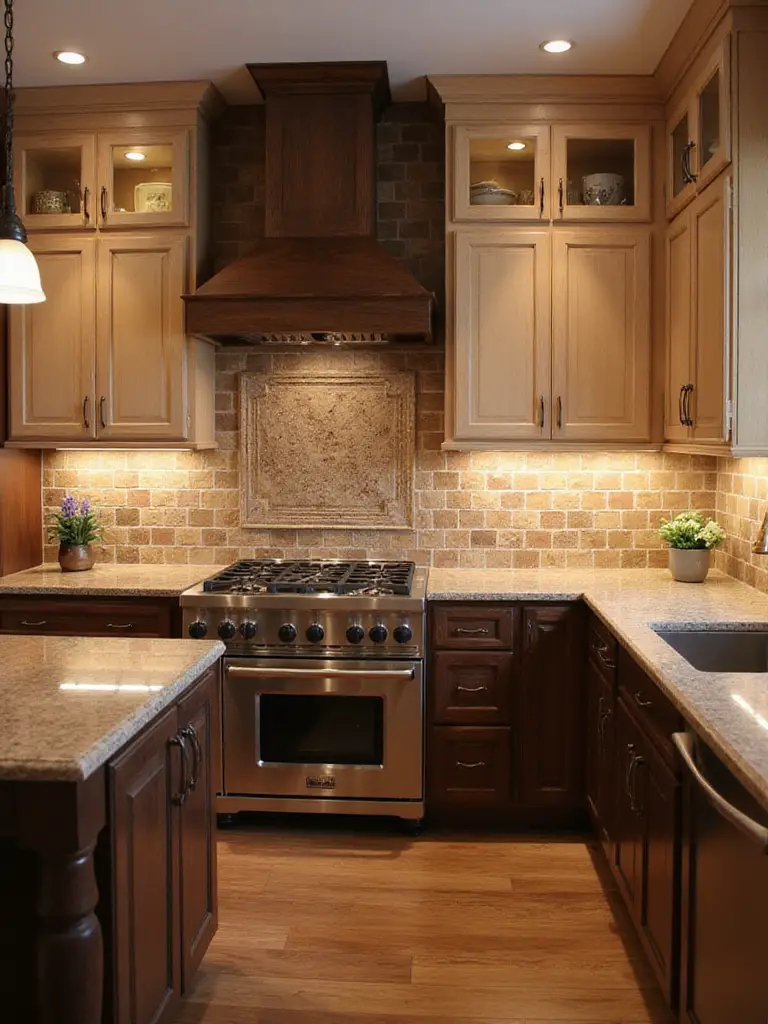
The practical benefits of chocolate brown cabinets include their ability to conceal fingerprints, water spots, and daily wear better than lighter colors, making them an excellent choice for busy families. When crafted from sustainable hardwoods and finished with low-VOC stains and topcoats, these cabinets contribute to healthier indoor air quality while showcasing the natural beauty of wood grain. The depth of chocolate brown allows it to pair beautifully with a wide range of countertop materials, from light marble to warm granite, creating versatile design possibilities.
Professional color matching ensures consistency across different cabinet components, while proper surface preparation allows the rich brown stain to penetrate evenly and cure to a durable finish that will maintain its beauty for decades. The investment in quality chocolate brown cabinets often increases home value significantly, as this timeless color choice appeals to a broad range of potential buyers.
Look closely and you’ll notice the subtle texture of hand-sanded surfaces that allow the chocolate stain to penetrate more deeply in some areas, creating natural variation that prevents the flat appearance of painted surfaces…
10. Create Contrast with Light Brown and White
The strategic pairing of light brown and white creates a kitchen design that feels both grounded and airy, leveraging the best qualities of each color to achieve perfect balance. Light brown elements – whether in cabinetry, flooring, or accents – provide warmth and natural connection, while white surfaces reflect light and create the perception of expanded space. This combination works particularly well in smaller kitchens or those with limited natural light, where the contrast prevents either color from overwhelming the space.
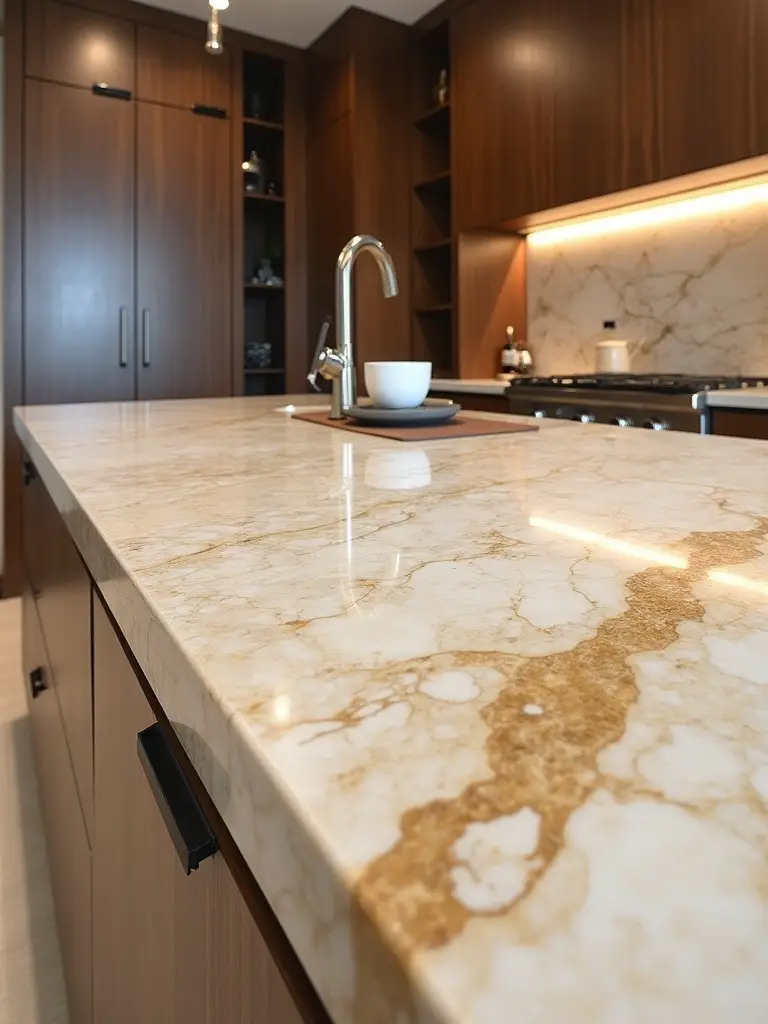
The environmental advantage of this palette lies in its timeless appeal, which reduces the likelihood of premature renovation and the associated waste. Light brown wood elements can be sourced from rapidly renewable species like bamboo or responsibly harvested hardwoods, while white surfaces can utilize recycled content quartz or reclaimed materials. The contrast between these colors highlights the natural grain patterns in wood while making white surfaces appear crisp and clean.
- Proportion Planning: Use the 60-30-10 rule with light brown as dominant, white as secondary, and accent colors as highlights
- Texture Mixing: Combine smooth white surfaces with textured brown elements for visual interest
- Lighting Considerations: Warm LED lighting enhances brown tones while maintaining the crispness of white elements
The unexpected pairing that always works is incorporating natural brass hardware, which bridges the warmth of brown with the cleanliness of white while adding a third dimension to the color story…
11. Incorporate Natural Brown Stone Elements
Natural brown stone elements bring geological beauty and environmental responsibility to kitchen designs while providing surfaces that improve with age and use. Materials like brown granite, sandstone, or slate offer unique patterns and colors that cannot be replicated artificially, ensuring your kitchen has distinctive character. The thermal mass of natural stone helps regulate kitchen temperatures, staying cool in summer and retaining warmth in winter, contributing to overall energy efficiency.
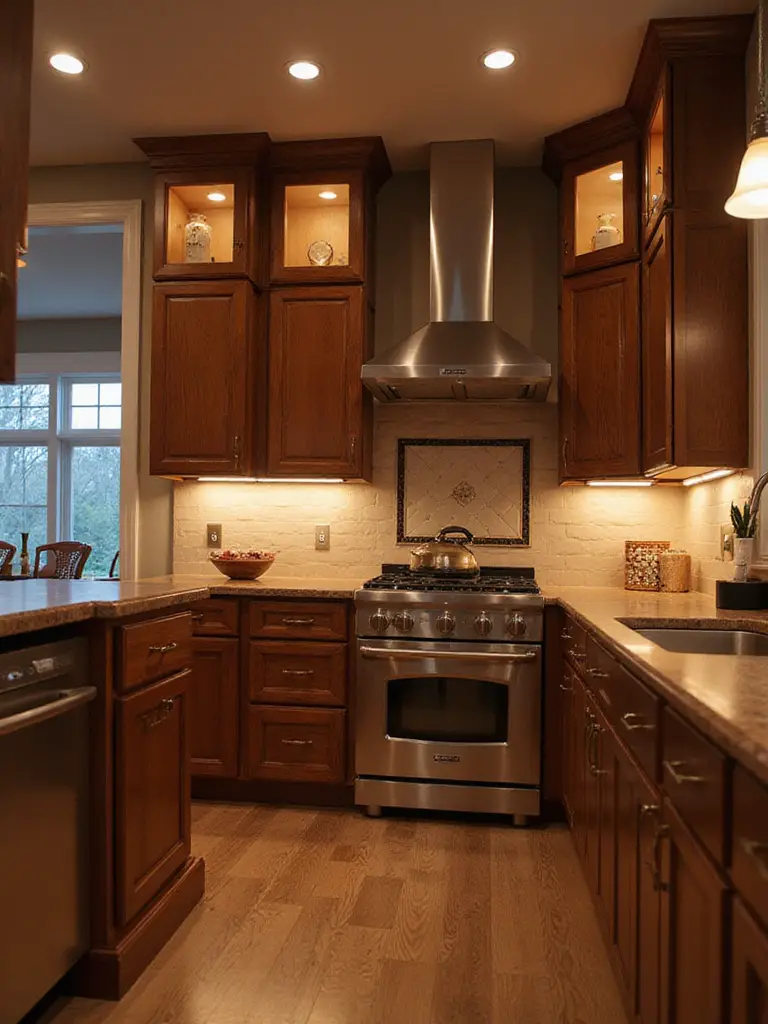
The quarrying process for responsibly sourced brown stone often supports local communities and traditional extraction methods that minimize environmental disruption. Many brown stones, particularly granite and slate, require minimal processing beyond cutting and polishing, reducing the energy consumption associated with their production. The longevity of natural stone – often lasting centuries with proper care – makes it one of the most sustainable material choices available for kitchen applications.
Different brown stones offer varying practical benefits: granite provides exceptional durability and stain resistance, sandstone offers natural slip resistance for flooring, and slate provides natural antimicrobial properties. The installation of natural stone elements requires skilled craftspeople who understand each material’s unique characteristics, supporting traditional building trades while ensuring proper performance.
The materials are sourced from a remarkable region where geological forces created unique mineral compositions over millions of years, resulting in brown stones with distinctive patterns and properties found nowhere else…
12. Design Brown Wood Open Shelving
Brown wood open shelving transforms storage into display opportunity while showcasing the natural beauty of sustainably sourced timber in kitchen environments. This approach reduces the visual weight of upper cabinets while providing accessible storage for frequently used items, dishes, and decorative objects that add personality to the space. The environmental benefit includes using significantly less material than closed cabinetry while allowing air circulation that helps prevent moisture buildup and extends the life of stored items.
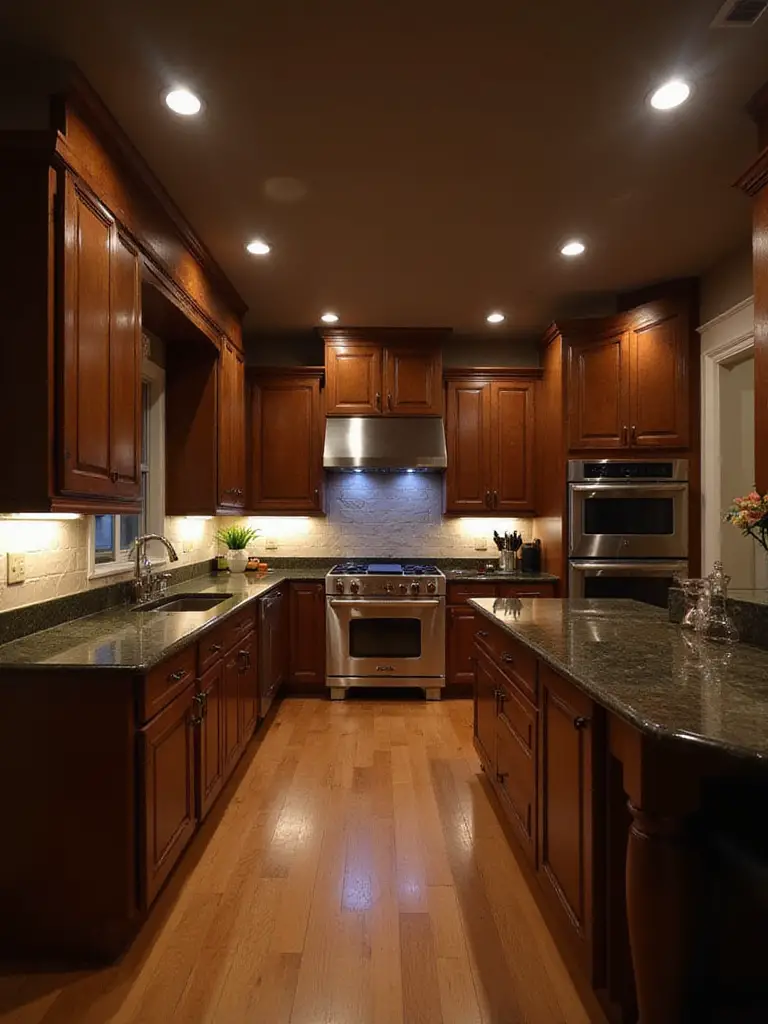
The selection of wood species for open shelving allows for creative expression within the brown palette – from light ash to deep walnut – while supporting responsible forestry practices. Reclaimed wood shelving carries additional environmental benefits by diverting materials from waste streams while providing unique character that new lumber cannot match. The installation process allows for adjustable heights and configurations that can evolve with changing needs, extending the useful life of the installation.
- Wood Species: Choose harder species like maple or oak for shelves that will support heavy dishes and appliances
- Bracket Selection: Hidden brackets create clean lines, while decorative brackets add architectural interest
- Spacing Guidelines: 12-15 inches between shelves accommodates most kitchen items while maintaining proportional appearance
The artisans’ commitment to environmental practices means selecting lumber from forests managed for long-term sustainability, where selective harvesting maintains ecosystem health while providing renewable building materials…
13. Install Brown Hardwood Ceiling Treatments
Brown hardwood ceiling treatments create architectural drama while bringing warmth overhead in kitchen spaces, transforming what is often an overlooked surface into a design feature that adds character and sophistication. This approach works particularly well in kitchens with higher ceilings, where wood planking or beams can create visual interest and help define the space. The acoustic properties of wood ceilings help absorb sound, making kitchens more comfortable for conversation and reducing the echo common in hard-surfaced rooms.
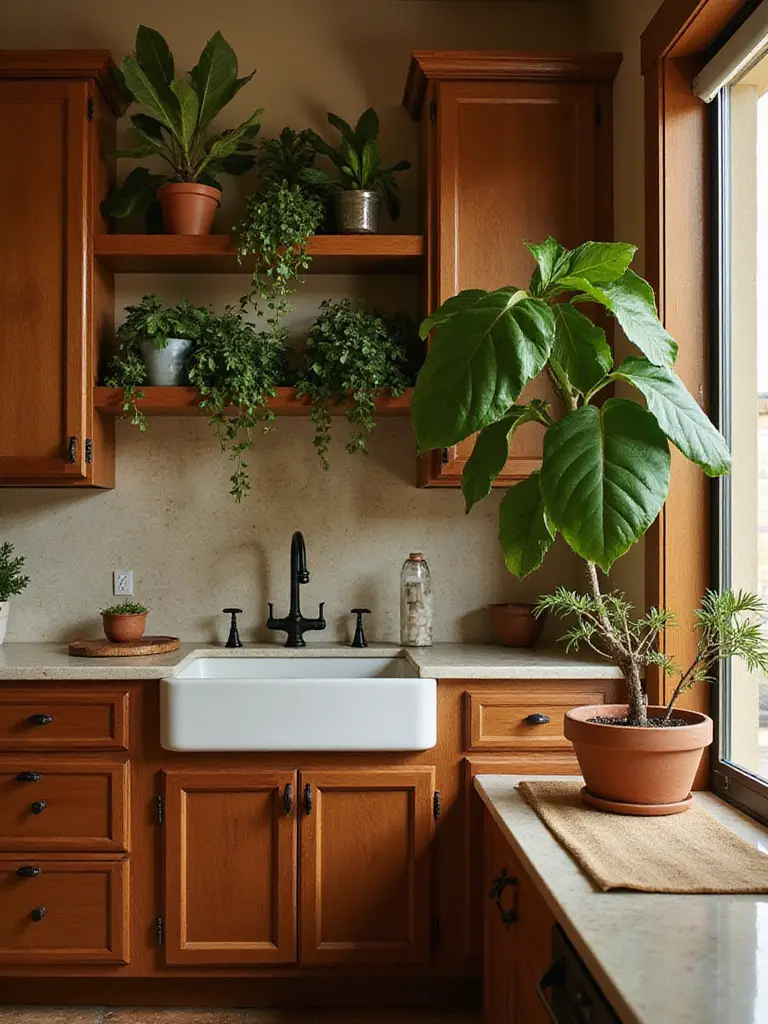
The environmental consideration involves selecting wood species and finishes that contribute to healthy indoor air quality while showcasing sustainable forestry practices. Reclaimed wood ceiling treatments offer exceptional character while diverting materials from waste streams, and their weathered patina adds instant authenticity that new materials cannot replicate. The installation process requires careful attention to moisture control and ventilation, as kitchen environments present unique challenges for wood applications overhead.
Different brown wood ceiling treatments create varying visual effects: tongue-and-groove planking creates linear rhythm, coffered designs add formal elegance, and exposed beam systems provide rustic charm. The finish selection affects both appearance and maintenance – natural oils enhance grain patterns while providing protection, while low-VOC polyurethanes offer durability with minimal environmental impact.
The cultural heritage preserved in reclaimed ceiling materials includes traditional joinery techniques and wood species that may no longer be readily available, connecting contemporary kitchens to historical building practices…
14. Create Brown Pantry Storage Solutions
Custom brown pantry storage solutions maximize organization while maintaining the warm, natural aesthetic that defines cohesive brown kitchen design. These systems, whether built-in or freestanding, utilize the natural beauty of wood grain while providing practical storage that adapts to changing needs. The environmental benefit includes using renewable materials that can be reconfigured, refinished, or repurposed rather than discarded when storage needs change.
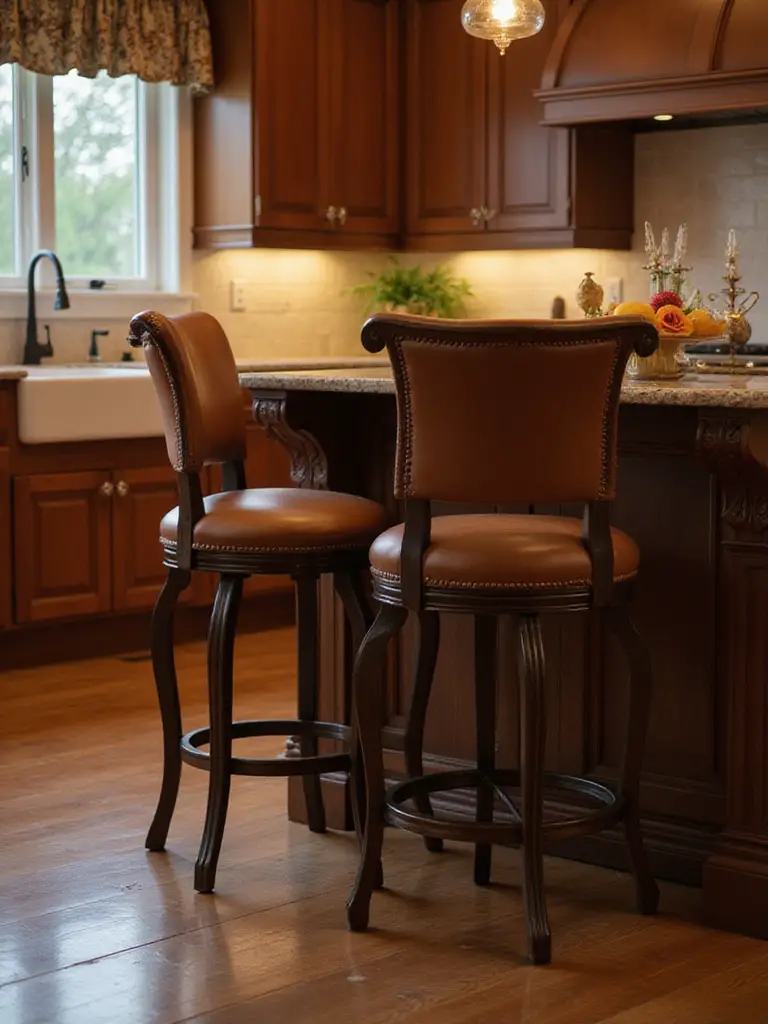
The design of brown wood pantry systems allows for creative solutions that address specific storage challenges – pull-out drawers for heavy items, adjustable shelving for varying container sizes, and specialized compartments for different food categories. Sustainable wood choices include rapidly renewable bamboo, reclaimed timber, or responsibly harvested hardwoods that support forest management practices. The natural antimicrobial properties of certain wood species help maintain food freshness while reducing the need for chemical treatments.
- Drawer Systems: Full-extension slides provide access to items stored at the back of deep shelves
- Adjustable Components: Modular systems adapt to changing storage needs over time
- Ventilation Planning: Proper air circulation prevents moisture buildup and extends food storage life
Professional stylists approach pantry organization by first categorizing items by use frequency, then designing brown wood storage solutions that make daily essentials easily accessible while maintaining visual cohesion…
15. Select Brown Natural Fiber Textiles
Brown natural fiber textiles bring softness and sustainability to kitchen environments while reinforcing the organic aesthetic that makes brown kitchen ideas so appealing. Materials like jute, hemp, linen, and organic cotton in various brown tones provide texture and warmth while supporting agricultural practices that build soil health and sequester carbon. These textiles offer practical benefits including natural stain resistance, durability, and the ability to be composted at the end of their useful life.
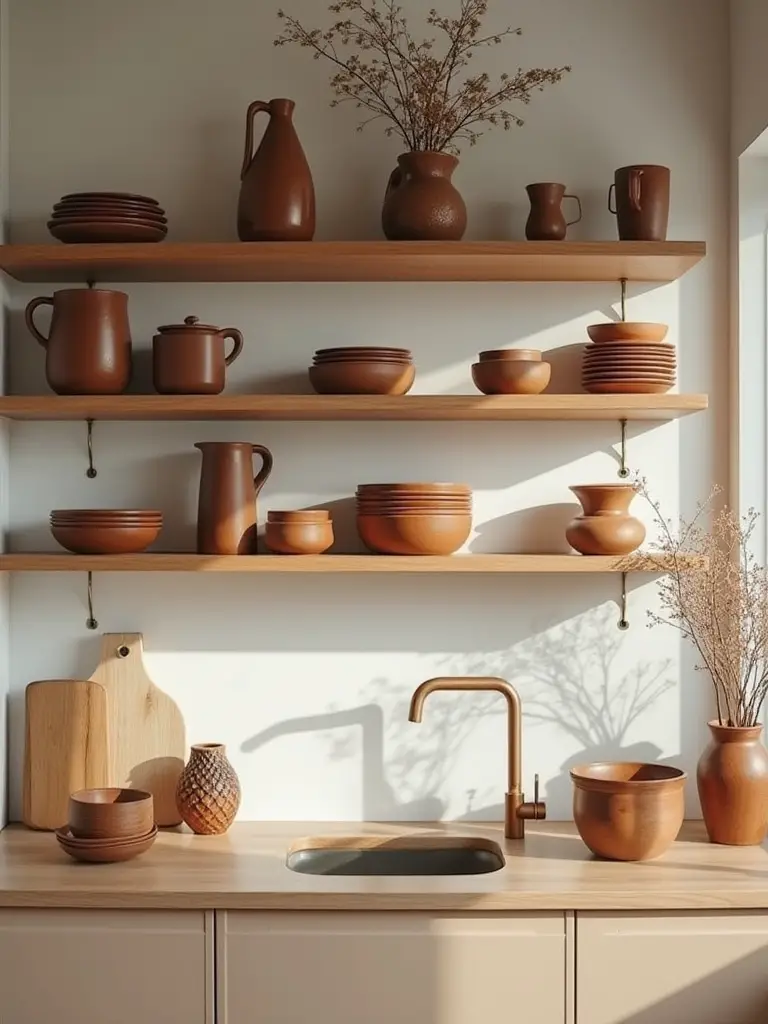
The production of natural fiber textiles in brown tones often utilizes plant-based dyes and low-impact processing methods that minimize water usage and chemical inputs. Many artisan textile producers specialize in traditional techniques that create unique textures and patterns while supporting rural communities and preserving cultural heritage. The versatility of brown natural fiber textiles allows them to serve multiple functions – window treatments, table linens, cushion covers, and decorative accents that can be easily changed with seasons or evolving tastes.
- Fiber Selection: Linen offers durability and improves with washing, while hemp provides exceptional strength
- Weave Patterns: Loose weaves create casual texture, while tight weaves offer more formal appearance
- Care Instructions: Most natural fibers benefit from air drying and minimal chemical treatments
The renewable resources used in these textiles demonstrate how agricultural crops can provide both food and fiber while building soil carbon and supporting biodiversity in farming systems…
16. Design Brown Ceramic Accent Pieces
Brown ceramic accent pieces add artisanal character to kitchen environments while supporting traditional pottery techniques and local ceramic artists. These handcrafted elements – whether functional vessels, decorative tiles, or sculptural objects – showcase the natural beauty of earth-based materials while providing unique focal points that mass-produced items cannot replicate. The firing process transforms local clay into durable, functional art that connects kitchens to centuries-old ceramic traditions.
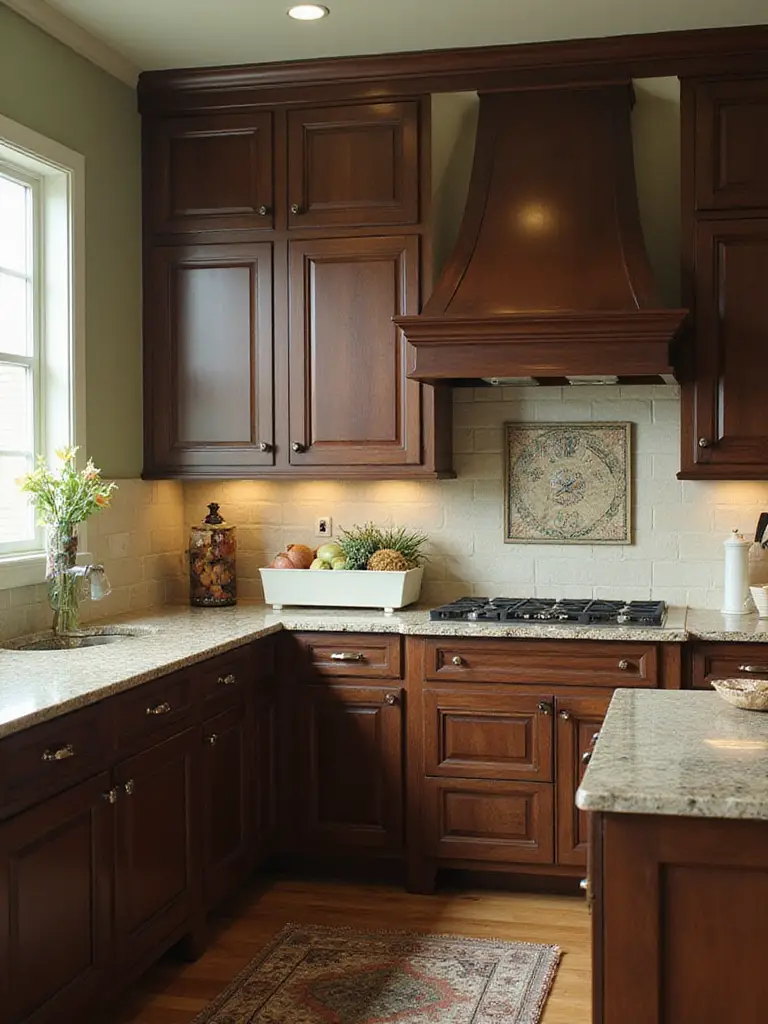
The environmental story of brown ceramics begins with locally sourced clay, which reduces transportation emissions while supporting regional ceramic traditions. Many pottery studios utilize renewable energy for kiln firing and recycle clay scraps back into new pieces, creating closed-loop production systems. The durability of well-made ceramics means these pieces can serve for generations, making them sustainable alternatives to disposable or short-lived decorative items.
Different ceramic techniques create varying brown tones and textures: reduction firing produces deep, rich browns with metallic highlights, while oxidation firing creates earthier, matte finishes. The handmade nature of ceramic accent pieces ensures slight variations that add character and prevent the uniformity of manufactured items.
The maker’s journey from apprentice to master ceramicist influences each piece, as years of experience inform decisions about clay preparation, glazing techniques, and firing schedules that determine the final character of brown ceramic accents…
17. Install Brown Leather Bar Seating
Brown leather bar seating combines luxury with sustainability when sourced from tanneries that use vegetable-based processes and support ethical livestock practices. The natural aging process of quality leather creates a patina that improves with use, making these pieces more beautiful over time rather than showing wear. This durability means leather bar seating can serve for decades with proper care, making it a sustainable choice that reduces the need for frequent replacement.

The comfort factor of brown leather seating cannot be overstated – the material breathes naturally, stays comfortable in varying temperatures, and provides support that improves with use as it conforms to individual body shapes. The manufacturing process for quality leather furniture often involves traditional techniques passed down through generations of craftspeople, supporting artisan skills while creating superior products. The variety of brown leather tones – from cognac to chocolate to tobacco – allows for perfect integration with other brown kitchen elements.
- Leather Grades: Top-grain leather offers the best combination of durability and natural appearance
- Frame Construction: Hardwood frames provide stability and longevity for daily use
- Maintenance Requirements: Regular conditioning preserves leather’s natural oils and prevents cracking
The environmental story behind ethical leather production includes supporting regenerative grazing practices that build soil health while providing sustainable livelihoods for farming communities…
18. Create Brown Glass Cabinet Displays
Brown glass cabinet displays showcase treasured items while adding sophisticated color and texture to kitchen storage solutions. The manufacturing process for brown glass often incorporates recycled content, reducing the environmental impact while creating beautiful, functional elements that filter light and add visual interest. These displays work particularly well for highlighting collections of pottery, glassware, or serving pieces that contribute to the overall brown aesthetic while remaining easily accessible.

The optical properties of brown glass create warm, filtered light that enhances displayed items while providing some protection from UV damage. Different shades of brown glass – from amber to bronze to deep chocolate – offer varying levels of transparency and color saturation, allowing for customized effects that complement other kitchen elements. The installation of brown glass requires careful attention to lighting design, as interior cabinet illumination can create stunning effects when filtered through colored glass.
Quality brown glass cabinet doors often feature traditional techniques like beveling or etching that add texture and visual interest while showcasing the material’s inherent beauty. The durability of glass makes it an excellent long-term choice, as it won’t fade, warp, or deteriorate like some other materials, ensuring consistent appearance for decades.
The discovery of this particular glass-making technique happened when artisan glassblowers experimented with adding iron oxide to traditional formulations, creating the rich brown tones that have become prized for architectural applications…
19. Incorporate Brown Metal Fixtures
Brown metal fixtures bring industrial elegance to kitchen environments while showcasing the beauty of materials like bronze, copper, and weathered steel in their natural brown patinas. These fixtures often improve with age as oxidation creates unique surface patterns that cannot be replicated artificially. The longevity of quality metal fixtures makes them sustainable choices that can serve for generations while developing character that enhances their visual appeal over time.

The manufacturing process for brown metal fixtures often involves traditional techniques like hand-forging, patination, and finishing that support artisan metalworkers and preserve traditional skills. Many metal fixtures can be restored or refinished rather than replaced, extending their useful life while maintaining their original character. The thermal properties of metal fixtures provide practical benefits in kitchen environments, as they conduct heat efficiently and resist moisture damage.
- Patina Development: Natural aging creates unique surface patterns that enhance visual interest
- Finish Options: Oil-rubbed bronze, antique copper, and weathered steel each offer distinct character
- Installation Considerations: Proper mounting ensures fixtures can support their intended loads safely
The collaboration between metalworkers and kitchen designers began with conversations about creating fixtures that would age gracefully while providing superior functionality in demanding kitchen environments…
20. Design Brown Concrete Countertop Elements
Brown concrete countertops offer unlimited customization potential while utilizing locally sourced aggregates and recycled materials that reduce environmental impact. The integral color process allows for rich brown tones that penetrate throughout the material, ensuring consistent appearance even with wear and minor damage. This approach supports local concrete artisans who specialize in decorative techniques while creating unique surfaces that cannot be replicated in mass production.
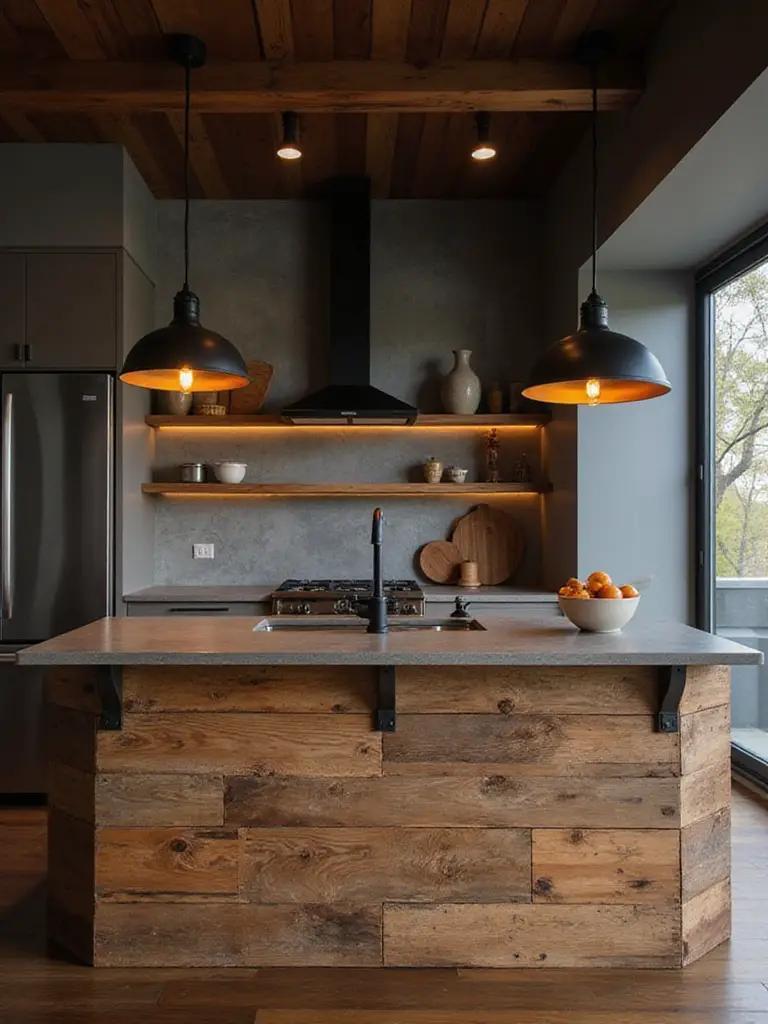
The thermal mass of concrete countertops provides practical benefits for cooking, as the material stays naturally cool for pastry work while retaining heat for bread proofing. The customization possibilities include embedded aggregates, integrated drainboards, and seamless integration with sinks or cooktops that create highly functional work surfaces. The curing process allows concrete to strengthen over time, making it increasingly durable with age.
Environmental benefits include using fly ash or recycled glass as partial cement replacement, reducing the carbon footprint while creating unique visual effects. The local production of concrete countertops eliminates shipping emissions while supporting regional craftspeople who understand local climate conditions and material sources.
The sustainable innovation narrative includes developing concrete mixes that sequester carbon as they cure, actually removing CO2 from the atmosphere while creating beautiful, functional surfaces that will serve for decades…
21. Install Brown Wood Wall Treatments
Brown wood wall treatments create architectural interest while bringing natural warmth to kitchen environments through carefully selected species and sustainable installation practices. These treatments range from full wall paneling to accent walls that highlight specific areas like dining nooks or coffee stations. The environmental benefit includes using rapidly renewable species or reclaimed materials that divert waste from landfills while providing unique character that new materials cannot match.
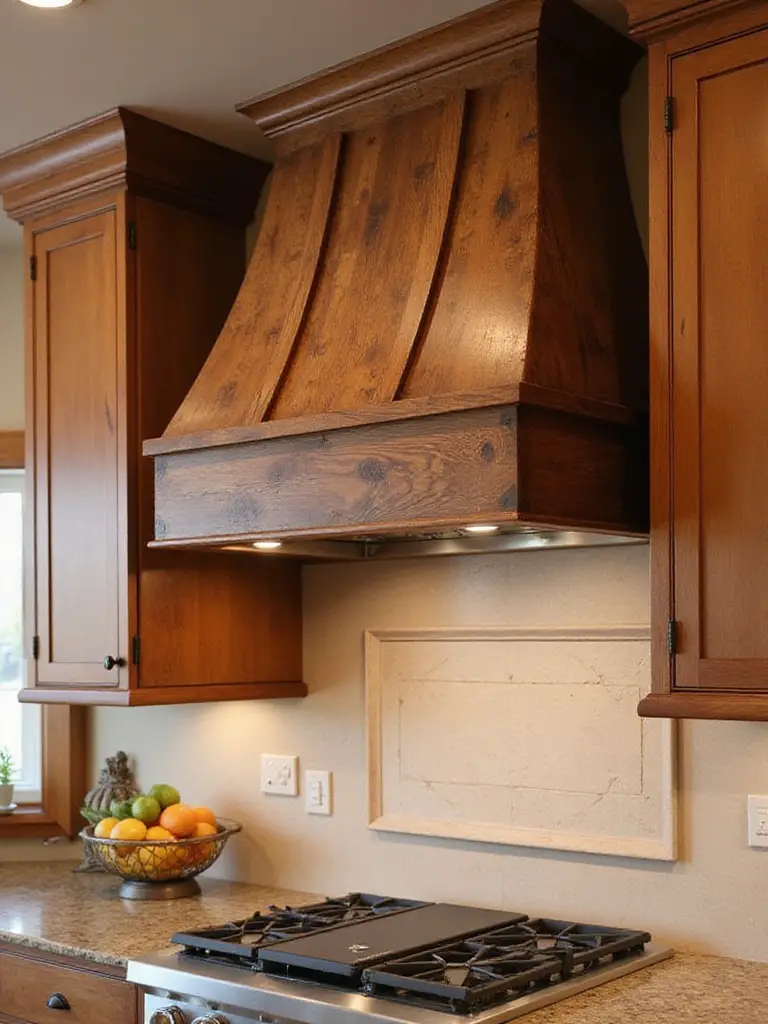
The acoustic properties of wood wall treatments help reduce noise in busy kitchens while adding texture that prevents the hard, echoing surfaces common in contemporary design. Different installation patterns – horizontal planking, vertical boards, or geometric arrangements – create varying visual effects while showcasing the natural grain patterns that make each installation unique. The selection of wood species allows for creative expression within the brown palette while supporting responsible forestry practices.
- Species Selection: Choose stable species like cedar or pine for humid kitchen environments
- Installation Methods: Floating systems allow for seasonal movement while maintaining appearance
- Finish Options: Natural oils enhance grain patterns while providing moisture protection
The forest management practices that produce this lumber include selective harvesting that maintains ecosystem health while providing renewable building materials that store carbon for decades…
22. Create Brown Mosaic Backsplash Patterns
Brown mosaic backsplash patterns offer unlimited creative potential while showcasing artisan tile-making techniques and supporting traditional ceramic arts. These intricate installations can incorporate various brown tones and materials – ceramic, stone, glass, or metal – to create unique patterns that serve as functional art in kitchen environments. The handcrafted nature of quality mosaic tiles ensures slight variations that add character while preventing the mechanical uniformity of mass-produced alternatives.
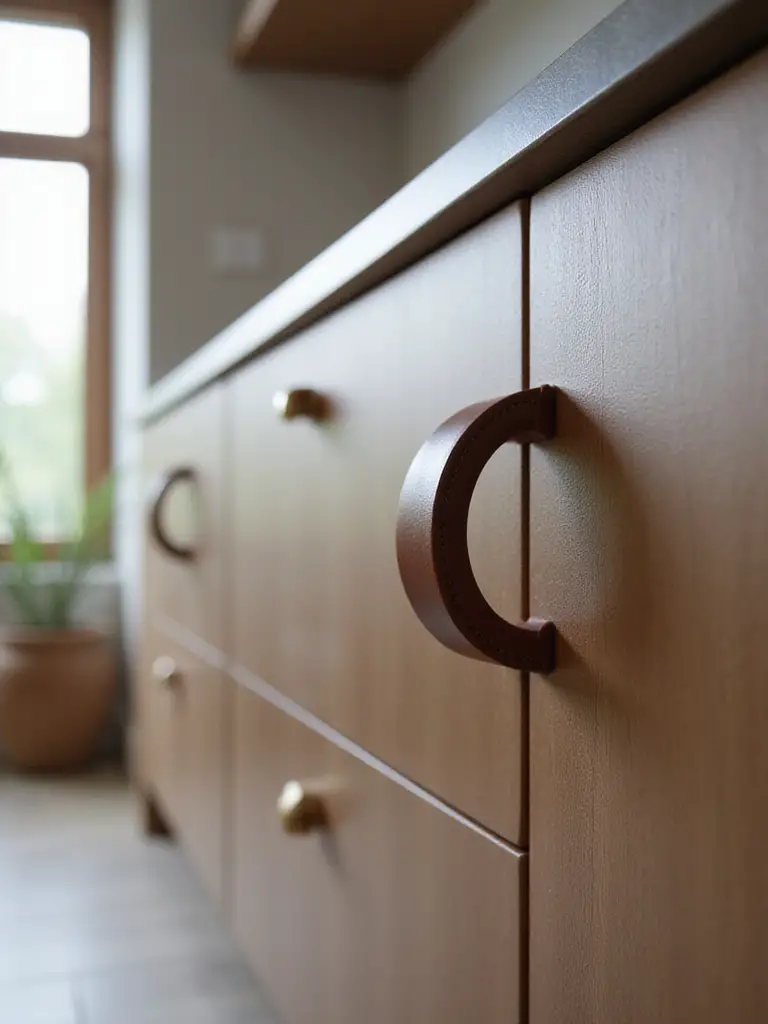
The installation process for brown mosaic backsplashes requires skilled craftspeople who understand pattern development, color flow, and grout selection to achieve professional results. The variety of brown materials available allows for creative combinations that can incorporate recycled content glass, natural stone, or handmade ceramics that support sustainable production practices. The durability of properly installed mosaic backsplashes means they can serve for decades while maintaining their original beauty.
Different mosaic patterns create varying visual effects: random patterns feel organic and natural, geometric arrangements provide formal structure, and gradient layouts create smooth color transitions. The grout selection significantly affects the final appearance, with matching grout creating seamless surfaces while contrasting grout emphasizes individual tile placement.
The artisan collective that creates these mosaic tiles maintains traditional techniques passed down through generations, ensuring each installation connects contemporary kitchens to centuries of ceramic artistry…
23. Select Brown Window Treatment Solutions
Brown window treatment solutions provide privacy and light control while reinforcing the natural aesthetic that defines cohesive brown kitchen design. Materials like bamboo, wood, or natural fiber fabrics in brown tones offer sustainability benefits while providing practical functions that enhance kitchen comfort and energy efficiency. The selection of natural materials supports renewable industries while creating window treatments that improve with age and use.
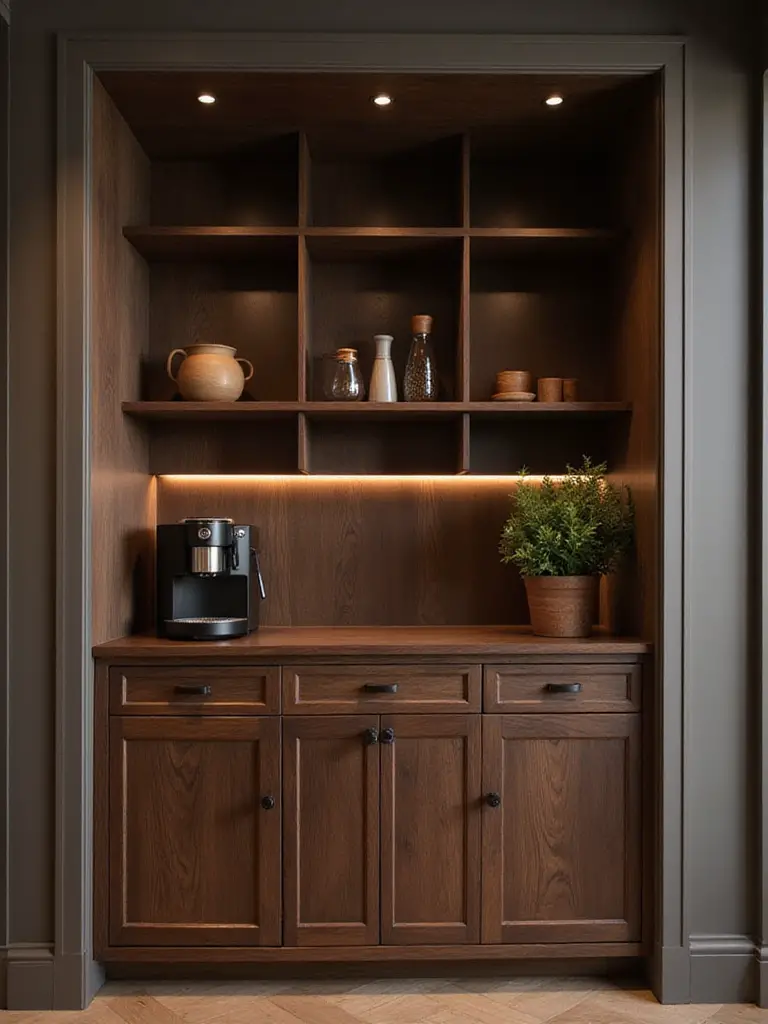
The light-filtering properties of brown window treatments create warm, diffused illumination that enhances other brown elements while reducing glare and UV damage to interior surfaces. Different materials offer varying levels of light control and privacy – bamboo blinds provide excellent ventilation, wood shutters offer precise light control, and fabric treatments add softness and acoustic benefits. The installation of quality window treatments can improve energy efficiency by providing insulation and reducing heat transfer.
- Material Durability: Natural materials like bamboo and wood resist fading and maintain appearance longer than synthetic alternatives
- Operating Systems: Cordless options provide safety while maintaining clean lines and easy operation
- Custom Sizing: Proper measurement ensures optimal fit and function for each window opening
The renewable journey of bamboo window treatments includes harvesting from rapidly growing grasses that regenerate without replanting while sequestering carbon and providing sustainable livelihoods…
24. Design Brown Kitchen Garden Elements
Brown kitchen garden elements bring fresh herbs and vegetables directly into cooking spaces while creating living connections to sustainable food systems. These installations – whether window herb gardens, vertical growing systems, or integrated planters – utilize brown containers and structures that complement other kitchen elements while providing fresh ingredients year-round. The environmental benefit includes reducing food miles, packaging waste, and pesticide exposure while creating educational opportunities about sustainable growing practices.
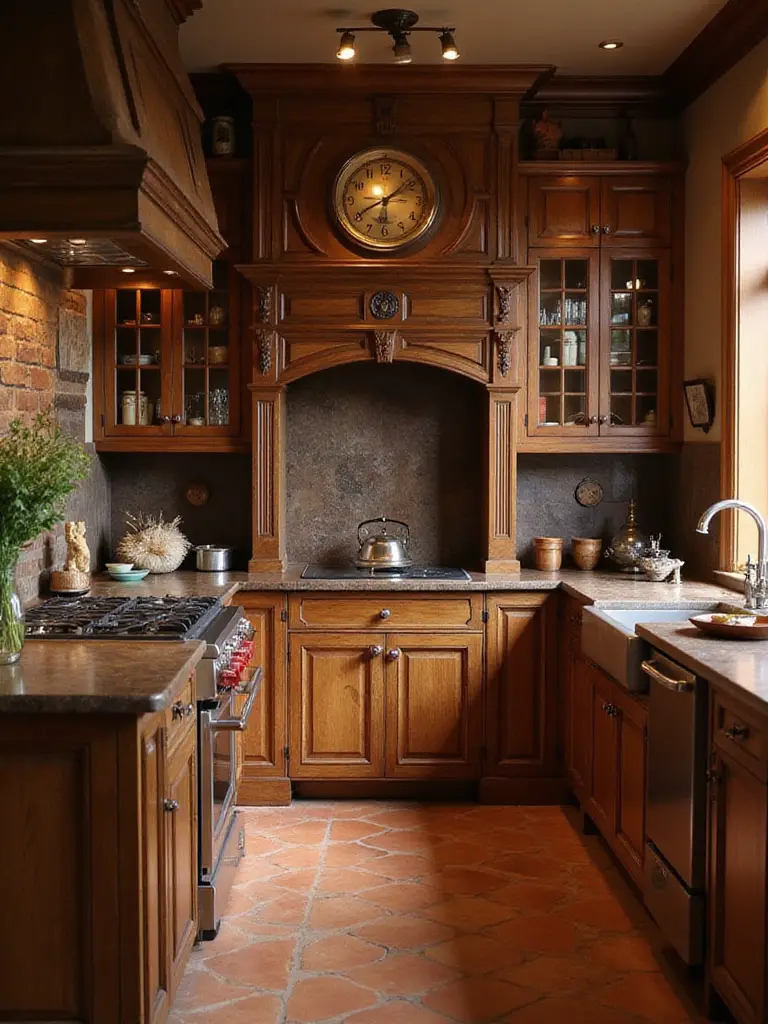
The selection of brown containers for kitchen gardens includes options like terra cotta, wood, or recycled materials that support plant health while maintaining aesthetic coherence. Different growing systems accommodate varying space constraints and skill levels – simple herb pots for beginners, hydroponic systems for year-round production, or integrated planters that become architectural features. The maintenance of kitchen gardens provides daily connection to natural cycles while ensuring fresh ingredients are always available for cooking.
The integration of kitchen gardens into brown design schemes creates living elements that change with seasons while maintaining consistent brown structural components. The selection of herbs and vegetables can emphasize varieties with brown stems, pods, or containers that reinforce the overall color palette while providing culinary diversity.
The organic growing methods used in kitchen gardens demonstrate how small-scale food production can eliminate chemical inputs while providing superior flavor and nutrition compared to commercial alternatives, creating sustainable food systems that begin in the kitchen…
Conclusion
These 24 brown kitchen ideas demonstrate the remarkable versatility and enduring appeal of this foundational color in creating spaces that feel both sophisticated and deeply welcoming. From the rich grain patterns of walnut cabinetry to the warm glow of honey oak flooring, each element contributes to an aesthetic that connects us to the natural world while supporting sustainable design practices. The beauty of working with brown lies in its ability to serve as both a neutral foundation and a statement-making feature, adapting to various design styles while maintaining its essential warmth and character.
The environmental considerations woven throughout these brown kitchen ideas reflect a growing awareness that beautiful design and ecological responsibility can work hand in hand. By choosing sustainably sourced materials, supporting artisan craftspeople, and selecting elements that improve with age rather than deteriorate, we create kitchens that honor both our aesthetic desires and our environmental responsibilities. These choices often result in spaces with greater character and longevity than those built with conventional materials, proving that sustainable design practices enhance rather than compromise the final result.
As you consider incorporating these brown kitchen ideas into your own space, remember that the most successful designs emerge from thoughtful selection and careful integration rather than wholesale adoption of trends. Start with elements that resonate most strongly with your lifestyle and aesthetic preferences, then build layers of brown tones and textures that create depth and interest while maintaining coherence. Your kitchen transformation awaits – a space where the timeless appeal of brown creates a foundation for countless meals, conversations, and memories to come.
